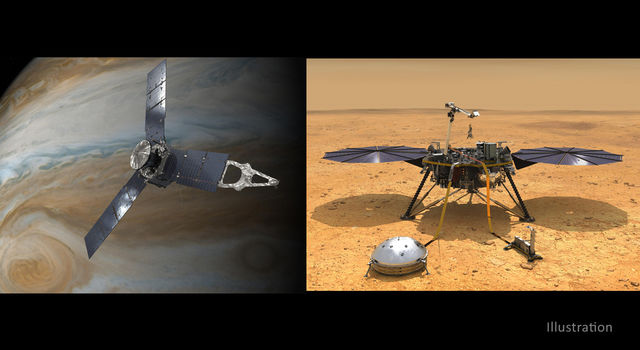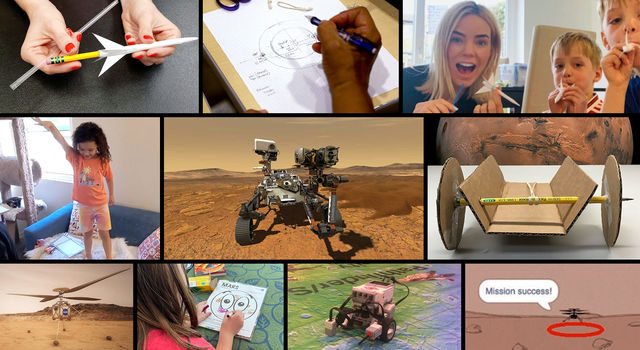Blogs | Landing Curiosity | August 5, 2012
Landing Curiosity - NASA's Next Mars Rover
TOUCHDOWN
Monday, August 6, 2012 1:13:26 AM
Welcome to Gale Crater. "Adam...you're a genius!" I shout to Adam Steltzner. He pauses. Stops. Turns around. "I'm not a genius -- I just work with a team of them."
Thanks for the ride
Sunday, August 5, 2012 10:04:10 PM
The EDL Phase Lead, Adam Steltzner, has just thanked the cruise team for their 350-million-mile ride. "Curiosity is in fantastic shape, she's here because you guys got her here. See you on Mars."
Go Curiosity. And break out the peanuts.
Mars really has us now.
Sunday, August 5, 2012 10:03:56 PM
Ten thousand and sixty three. Sixty four. Sixty five. As quick as you can count it, our speed towards Mars is accelerating.
Mars is about half the diameter of Earth, but only about 10 percent as heavy as Earth. Even so -- on its surface, gravity is about 38 percent that of Earth. In the next 28 minutes, we will gain another 3,000 miles per hour until Curiosity, heatshield ready, slams into the top of the Martian atmosphere.
40 billion to 1
Sunday, August 5, 2012 9:15:28 PM
A quiet approach to Mars as we watch a tiny plot of a graph. The X-band frequency that Curiosity is currently transmitting is a frequency of more than 8 Gigahertz -- 8 billion cycles per second. As it rotates, that tiny little graph shows that frequency moving up and down, by about 0.2 Hz. One part in 40 billion. That little bounce up and down is the rotation of the spacecraft, two revolutions per minute. We have that accuracy because we're bouncing a radio signal from the ground, up to spacecraft and back again. But that signal, after a final poll, will be going away.
Systems Go. Power Go. Thermal Go. Propulsion Go. Nav Go. Uplink Go. Avionics Go. Flight. Software Go. Fault Protection Go. Chief Engineer Go. EDL FLight System Go. Data Management Go. GDS Go. Telecom Go. ACS Go. EDL Activity Lead Go. ACE Go.
"You are clear to bring down the uplink." So in just over 13 minutes time, Curiosity will no longer have that amazing signal to bounce back - and our little squiggly 1-in-40-billion line will be gone. We will just hear the spacecraft's own transmitter from more than 150 million miles.
Curiosity is truly on her own.
A Final Check
Sunday, August 5, 2012 8:44:21 PM
This full poll of the flight team is a lengthy and exhaustive tour of the rover, the cruise stage and all the systems. My favorite call is from the chief engineer:
"We are green across the board"
That's the word from Rob Manning -- a veteran of four successful Mars landings. When Rob says things are green, you know you're in good shape. If you were hoping to spend some time exploring the martian moon Deimos on your way to Gale Crater -- please alight the rover now, we just crossed its orbit. Now there are 16,000 miles to go.
Calm before the Storm
Sunday, August 5, 2012 8:32:58 PM
Things got a little quiet in the control room. People heading out for some food before we get down to the business of landing on Mars. It takes huge team to watch over a spacecraft as complex, and activites and intricate as a Mars landing. As they get back to their consoles, they do a comm check to make sure they can all hear each other. Systems. Power. Thermal. Prop. Nav. Uplink. Flight Software. Fault Protection. EO Team Chief. GDS. Telecom. EDL Comm. ACS ... the calls, and acronyms, go on and on. Now they are all back on console, the whole team is about to do a full system poll.
Can you hear me?
Sunday, August 5, 2012 7:59:37 PM
Between now and landing, Curiosity will use a total of eight antennas. The Deep Space Network is now listening to a medium-gain antenna transmitting on X-Band on the cruise stage. During entry, two low gain antennas on the back of the spacecraft continue that signal of "tones." There are also low-gain antennas on the descent stage and the rover. However, Earth will have set at this time.
Meanwhile, a UHF antenna on the backshell, followed by another on the descent stage and finally one on the rover, will continue to transmit telemetry during landing. This data will be received by Mars Odyssey and Mars Reconnaissance Orbiter. Odyssey will relay it straight to Earth so we can track landing. Mars Reconnaissance Orbiter records everything it hears and sends it back a few hours later. Mars Express will also record just the pitch of this signal as a final backup.
The ground stations at the Canberra, Australia Deep Space Communications Complex will follow us the whole way -- direct from the rover 'til Earth sets behind it -- and from Odyssey and Mars Reconnaissance Orbiter as well. All the way to the ground, a complex system of systems will be trying to keep that tenuous link between Earth and Mars alive.
Nominal!
Sunday, August 5, 2012 5:58:00 PM
"Nominal" sounds like a very boring word, but in the world of spaceflight, nominal is engineer for "awesome." Thanks to the Deep Space Network, we know just how nominal everything is. Deep Space Station 43, a 70-meter-diameter antenna in Tidbindilla, Austraila is currently receiving a steady stream of data at 2,000 bits per second that informs the engineers how all their subsystems are doing. Attitude control, thermal performance, power systems, avionics, propulsion, communication, the list is long. The flight team (meet them all here: www.gigapan.com/gigapans/110926) just took a poll, and all subsystems are nominal. The MEDLI instrument is now powered up, and healthy. It's talking to the flight computer, and the power system can see it drawing just 300 milliamps. It will record first-of-its-kind data on temperature, pressure and other readings through Curiosity's heatshield during entry. This data will help us understand how the heatshield behaves and can help us make them better for the future. As MEDLI lives on the inside of the heatshield, it is thrown overboard when the heatshield is separated about six miles above the surface. Its data will be safely stored on the rover to be downlinked after landing.
Spin
Sunday, August 5, 2012 1:15:54 PM
When you're a spacecraft it's important to know which way you're facing. If you know which way you're facing, you know which way Earth is, so you can talk to home; which way the sun is, so you can get power on a solar array; and if you're Curiosity, you know which way Mars is. There are two ways spacecraft typically orient themselves. One is called "three-axis stabilized," which means the spacecraft uses thrusters and reaction wheels to keep itself pointed the right way. You may have heard about trouble with reaction wheels on the Mars Odyssey orbiter recently (it carries a spare just in case, and we're now using it). Curiosity (as well as its older sisters Spirit and Opportunity, and Juno right now on its way to Jupiter) just spin their way through deep space. They point in one direction and spin, like a top. That spin stops the spacecraft wandering off and pointing somewhere else. Curiosity, all the way till after we wave goodbye to its cruise stage about 17 minutes before landing, spins at 2 rpm. During its 253-day cruise, Curiosity will have spun more than 720,000 times. It's enough to give a rover a headache.
Three Degrees
Sunday, August 5, 2012 1:05:01 PM
I've arrived "on lab" (JPL-speak for "at the office") to check up on our computer running Eyes on the Solar System (http://eyes.nasa.gov) that will be fed to NASA Television tonight. Looking up in the control room -- I see we've just crossed 80,000 miles to go. Less than four- times the distance from Earth to our geostationary communication satellites. Mars is about 4,200 miles in diameter - so with a little high school trig, we can calculate that Mars would appear 3 degrees across to Curiosity. That's six times larger than the size of the full moon from Earth. This time yesterday, Curiosity was only 170 mph slower than it is now. In the next 10 hours as it falls to Mars it gains another 5,000. As an astronaut onboard Apollo 13 said to mission control on their way home, "The world's getting awful big in the window."
The Runners Up
Friday, August 3, 2012 11:15:00 AM
Adam Steltzner (MSL EDL phase lead) is a great speaker and real highlight of today's NASA Social event. A fantastic question from the audience asked what ideas for landing Curiosity were rejected.
The runner-up: airbags. There isn't a fabric that we know of strong enough to handle the impact loads that a 899-kg rover would create. Good enough for the 180-kg of Spirit and Opportunity, but it just can't get scaled up to something as big as Curiosity.
Third place: Put the rover on top of the rockets. The problem there is that the rover is so heavy, and the propellant tanks so large, that you would have a very tall vehicle prone to toppling over on touchdown.
It may look a little crazy -- but the skycrane actually makes a lot of sense.
Speed Up, Slow Down
Thursday, August 2, 2012 5:12:47 PM
The art of flying between the planets is a balancing act of gravity, velocity, trajectory and timing. These variables come to a thrilling climax on Sunday evening as Curiosity reaches the Red Planet.
Launched into a trajectory around the sun in November 2011, Curiosity is currently in a solar orbit that just reaches the orbit of Mars. That trajectory means that, from the perspective of the sun, by noon Pacific time on August 1 Curiosity was travelling at 47,500 miles per hour. Yet Mars is travelling at more than 53,000 mph -- some 5,500 mph faster than Curiosity. Left alone, Curiosity would soon begin a slow cruise back towards the orbit of Earth, while Mars would carry on along its own, faster trajectory.
But breathtaking accuracy by the navigation team guiding Curiosity means that Mars will be at the right place Sunday to pick up Curiosity. The planet's gravity will speed up the spacecraft by 13,000 mph (as viewed from the sun) until their speeds match and Curiosity is safely on the surface. On the freeway of interplanetary navigation, Curiosity is the bug, and Mars is the windshield. To get ready for a martian year of exploration, you've got to take a big hit.
Welcome to the Landing Blog
Thursday, August 2, 2012 5:12:16 PM
Welcome to the Curiosity landing blog. I'm Doug Ellison, a visualization producer here at JPL. Our group is responsible for many of the graphics you will see that show how Curiosity has made its way to Mars, and what it will do when it gets there.
The landing animation was a nine-month-long project of obsessing over details of every piece of the spacecraft and its adventure. We've launched a special version of Eyes on the Solar System at http://eyes.nasa.gov that lets you ride with Curiosity all the way to the surface. We've become so familiar with the spacecraft and what it does that we even surprise the mission team themselves sometimes!
On landing night, I'll be in our mission control (the "Dark Room") keeping you up to date with some of the goings-on as Curiosity approaches Mars. Until then I'll post a few little factoids about Curiosity, its trip to Mars, and its epic landing at Gale Crater.
TAGS:CURIOSITY, ROVERS & LANDERS, MARS, SOLAR SYSTEM, SPACECRAFT, MISSION, LIVE BLOG







